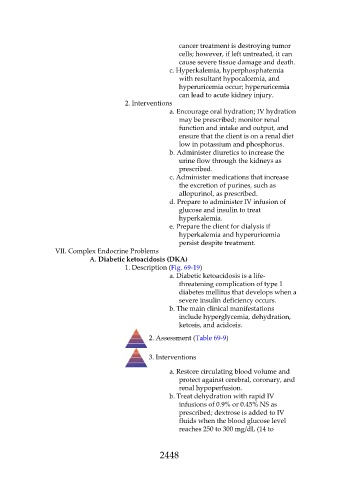Page 2448 - Saunders Comprehensive Review For NCLEX-RN
P. 2448
cancer treatment is destroying tumor
cells; however, if left untreated, it can
cause severe tissue damage and death.
c. Hyperkalemia, hyperphosphatemia
with resultant hypocalcemia, and
hyperuricemia occur; hyperuricemia
can lead to acute kidney injury.
2. Interventions
a. Encourage oral hydration; IV hydration
may be prescribed; monitor renal
function and intake and output, and
ensure that the client is on a renal diet
low in potassium and phosphorus.
b. Administer diuretics to increase the
urine flow through the kidneys as
prescribed.
c. Administer medications that increase
the excretion of purines, such as
allopurinol, as prescribed.
d. Prepare to administer IV infusion of
glucose and insulin to treat
hyperkalemia.
e. Prepare the client for dialysis if
hyperkalemia and hyperuricemia
persist despite treatment.
VII. Complex Endocrine Problems
A. Diabetic ketoacidosis (DKA)
1. Description (Fig. 69-19)
a. Diabetic ketoacidosis is a life-
threatening complication of type 1
diabetes mellitus that develops when a
severe insulin deficiency occurs.
b. The main clinical manifestations
include hyperglycemia, dehydration,
ketosis, and acidosis.
2. Assessment (Table 69-9)
3. Interventions
a. Restore circulating blood volume and
protect against cerebral, coronary, and
renal hypoperfusion.
b. Treat dehydration with rapid IV
infusions of 0.9% or 0.45% NS as
prescribed; dextrose is added to IV
fluids when the blood glucose level
reaches 250 to 300 mg/dL (14 to
2448

